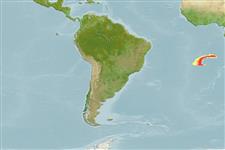Teleostei (teleosts) >
Beryciformes (Sawbellies) >
Melamphaidae (Bigscale fishes or ridgeheads)
Etymology: Melamphaes: Greek, melan, -anos = black + Greek, amphi = both side (Ref. 45335).
Eponymy: Professor Carl Levitt (Leavitt) Hubbs (1894–1979) was a giant of American ichthyology. [...] (Ref. 128868), visit book page.
Environment: milieu / climate zone / depth range / distribution range
Ecology
Marine; bathypelagic; depth range 0 - 150 m (Ref. 37108). Deep-water; 11°S - 19°S, 13°W - 1°W (Ref. 117121)
South Atlantic:
Length at first maturity / Size / Weight / Age
Maturity: Lm ?, range 3 - ? cm
Max length : 2.5 cm SL male/unsexed; (Ref. 117121)
Short description
Identification keys | Morphology | Morphometrics
Dorsal spines (total): 3; Dorsal soft rays (total): 14 - 16; Anal spines: 1; Anal soft rays: 8; Vertebrae: 28 - 29. This species is distinguished by the following characters: gill rakers on first gill arch 14-16; suborbital bone width is significantly larger than eye diameter; total vertebrae 28-29 (abdominal 12); haemal arch of first causal vertebra without spurs; D III,14-15; A I,8: P 15; V I,7; with ventral fin starting behind vertical line of posterior margin of pectoral fin basement; anal fin begins under third-fourth rays of the dorsal fin from its end; absence of black dotted pigment spots on either head or body (Ref. 117121).
Life cycle and mating behavior
Maturity | Reproduction | Spawning | Eggs | Fecundity | Larvae
Maul, G.E., 1990. Melamphaidae. p. 612-618. In J.C. Quero, J.C. Hureau, C. Karrer, A. Post and L. Saldanha (eds.) Check-list of the fishes of the eastern tropical Atlantic (CLOFETA). JNICT, Lisbon; SEI, Paris; and UNESCO, Paris. Vol. 2. (Ref. 4502)
IUCN Red List Status (Ref. 130435: Version 2024-1)
Threat to humans
Harmless
Human uses
Tools
Special reports
Download XML
Internet sources
Estimates based on models
Preferred temperature (Ref.
123201): 2.4 - 23, mean 12.5 °C (based on 64 cells).
Phylogenetic diversity index (Ref.
82804): PD
50 = 0.5000 [Uniqueness, from 0.5 = low to 2.0 = high].
Bayesian length-weight: a=0.01072 (0.00442 - 0.02595), b=3.10 (2.89 - 3.31), in cm total length, based on LWR estimates for this (Sub)family-body shape (Ref.
93245).
Trophic level (Ref.
69278): 3.2 ±0.2 se; based on size and trophs of closest relatives
Resilience (Ref.
120179): High, minimum population doubling time less than 15 months (Preliminary K or Fecundity.).
Fishing Vulnerability (Ref.
59153): Low vulnerability (10 of 100).
